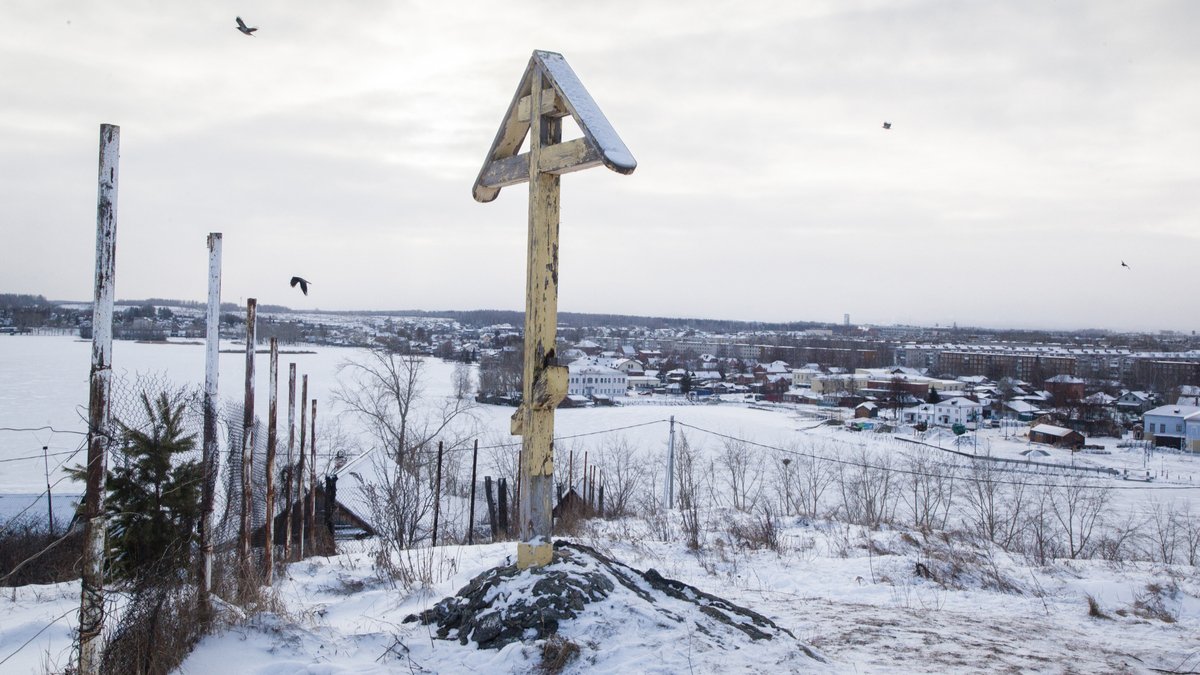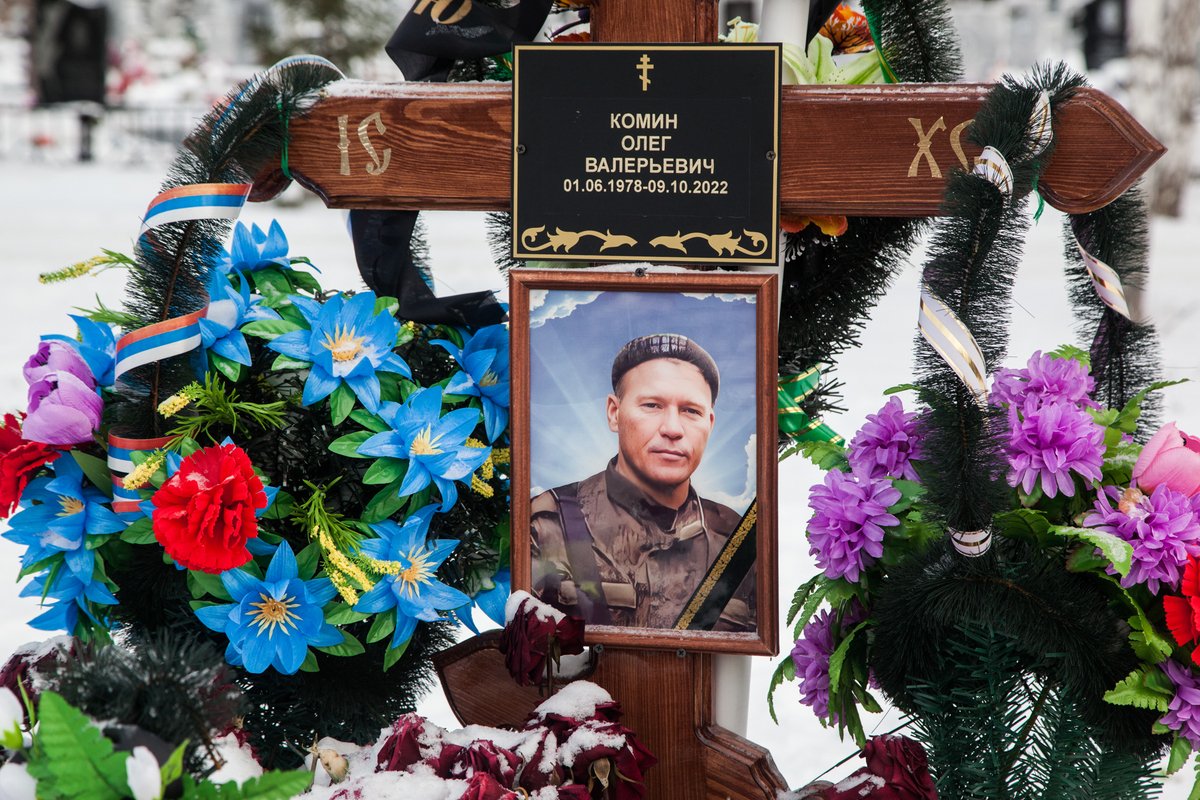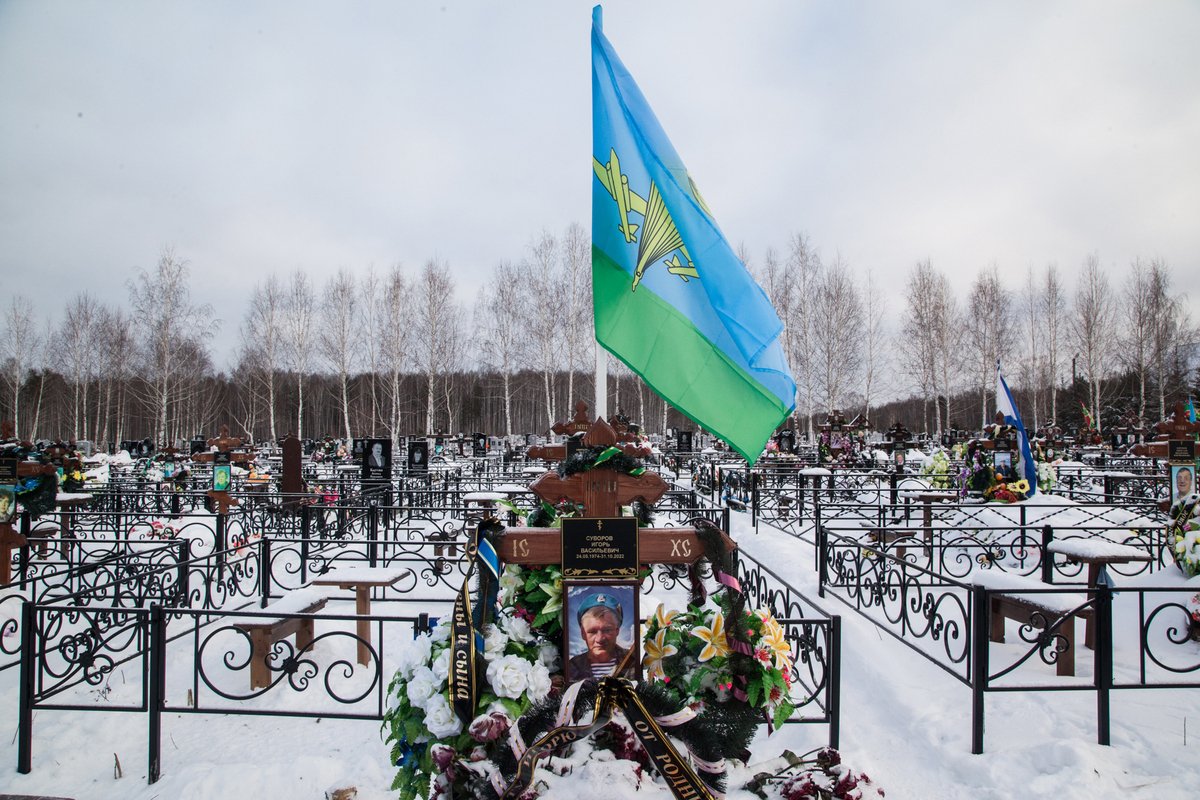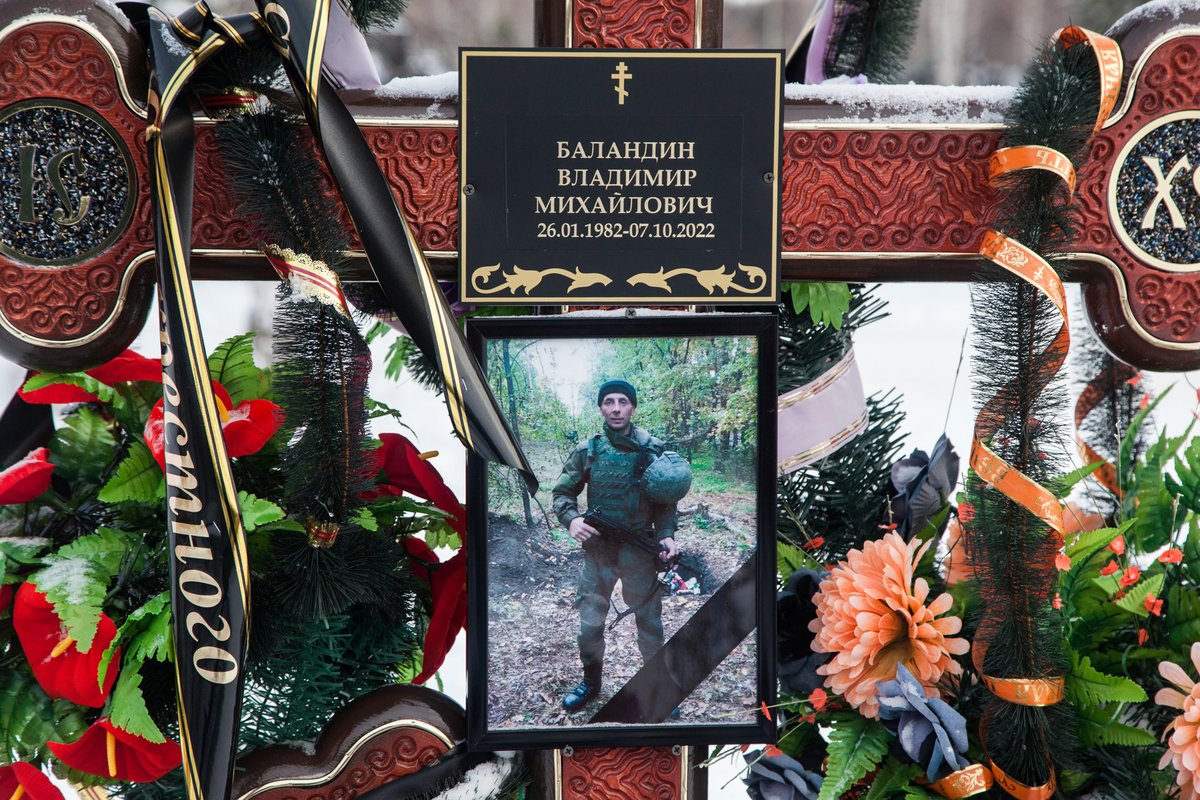Flags with Russian military slogans “We don’t abandon our own” and “Quiet comes after us” are fluttering in the freezing wind. Ivan (name changed), a 40-year-old local resident, and I are walking in between the fresh graves dug up in the snow-covered cemetery of the town of Nevyansk.
There are many paper flowers here. Plastic wreaths are still vividly colourful. Almost identical crosses are installed on five tombs near the central entry. The land nearby has not been dug up so as to leave space for future soldier graves; “normal” people are buried farther away.
Easy-going man in his forties
Nevyansk is a town in the Yekaterinburg region of Russia, with a population of 22,000 people. The town is not very prosperous, but one can find a job if they put their mind to it. There are several big factories and a penitentiary located here. Lately, the local cemetery has also been scaling up its production, too, if it can be called that.
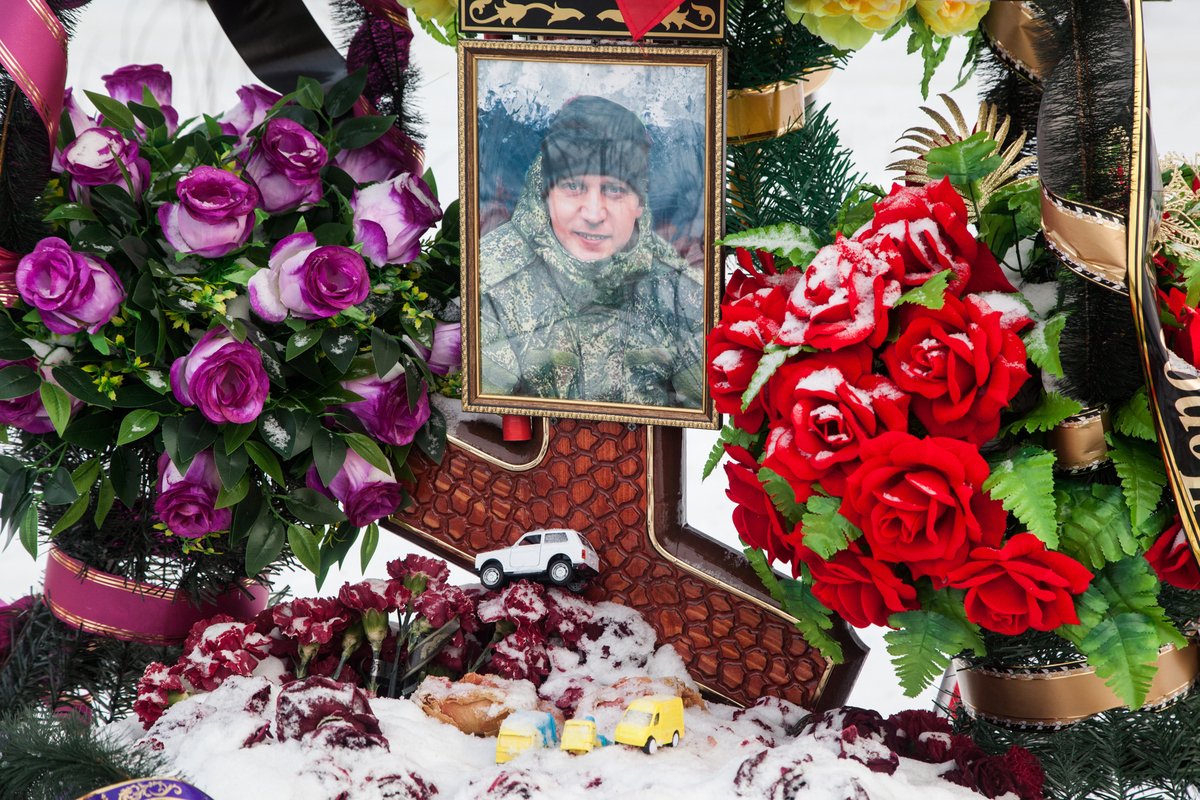
The cemetery of Nevyansk. Photo: Alexey Piskunov, exclusively for Novaya Gazeta Europe
“Vladimir Balandin,” Ivan reads the plaque and studies the face [of one of the local draftees killed in Ukraine] on the portrait. “I didn’t know him personally, but I saw the post announcing his death. He has four children.”
Ivan recalls another killed soldier — Igor Mokhov, who was buried in the nearby village of Serbishino. Igor was full of talent; he did voiceovers for children’s fairy tales. His art was known and loved by many in the town.
Ivan says that if one were to picture Nevyansk as a person, then it would be an easy-going man in his forties, kind-hearted and always ready to help, with an open face, just like the portraits on the crosses.
“I was born in Nevyansk,” Ivan continues. “I love my town, it’s full of prospects, it’s located close to Yekaterinburg and Nizhny Tagil, two biggest cities in the region. There is a lot here that could be cultivated; if the budget went on the town’s needs instead of being embezzled by officials, then Nevyansk would become beautiful. My friends have left the town, I will, most likely, leave too. There aren’t many young people here: no higher education institutions. Students leave for bigger cities to study a profession, they rarely return. I remember from my school days: standing on the platform, waiting for the Yekaterinburg — Nizhny Tagil train, only young people around. During weekends, the town becomes bigger, comes alive; during weekdays, it thins and turns quiet.”
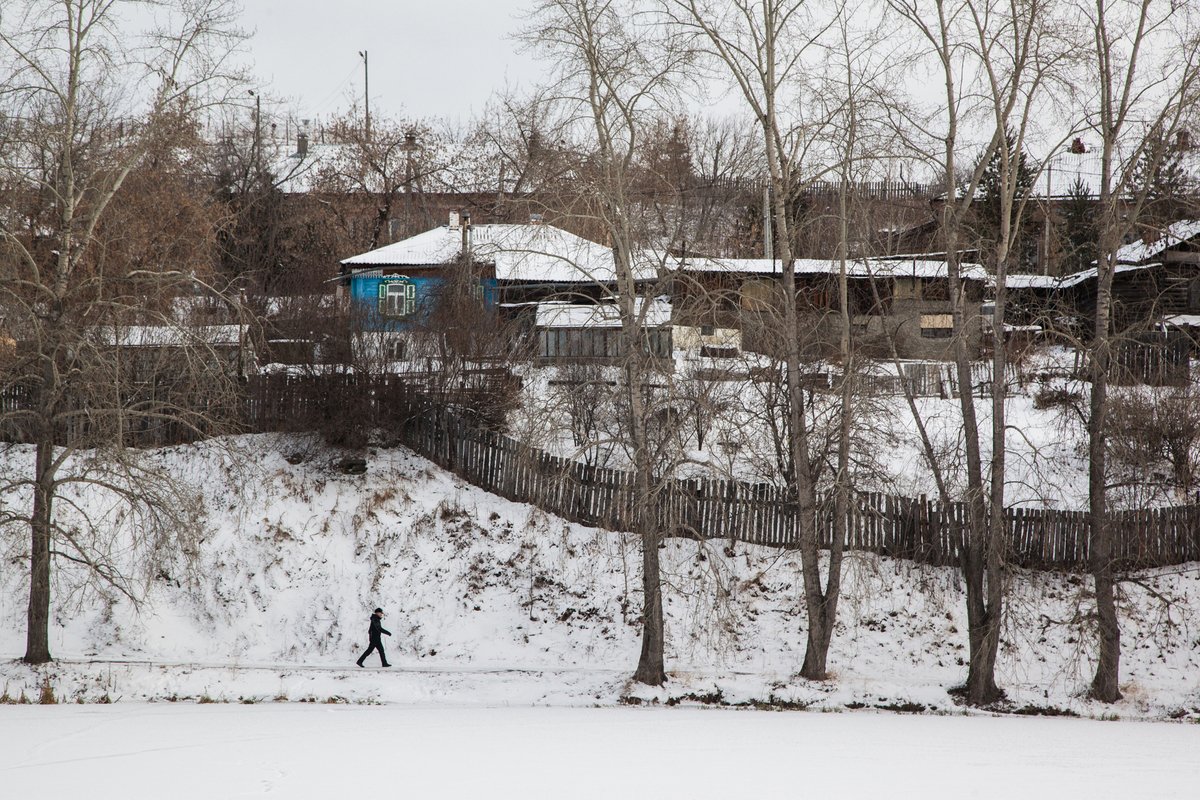
The Nevyansk pond embankment. Photo: Alexey Piskunov, exclusively for Novaya Gazeta Europe
Ivan is convinced that at first, the locals’ opinion on the “special military operation” was a patriotic one, some people were eager to join the army as volunteers. He thinks that the patriotic mood is no longer felt in the town today. Among Ivan’s friends, one went to fight in Ukraine as a volunteer, he is still there. Several of his friends were mobilised.
“I haven’t served in the army because of my health,” Ivan goes on. “But my [military] category means that the second [mobilisation] wave could include me too. If I get drafted, I won’t be looking for a way out. My friends say the same: ‘I won’t stay on the sidelines if I get mobilised,’ this is a way to support those who went [to war]. But I’m not a fan of this whole thing, I’m not pro-Ukrainians and not pro… I don’t like that fighting began, in February. To be honest, although I followed the news, I never did comprehend why. A few days before 24 February, I was on a train and saw several cargo trains carrying tanks. I thought: why so many? Full-scale drills? It made me tense and gave me a cold shiver. But back then, I didn’t even realise what was happening.”
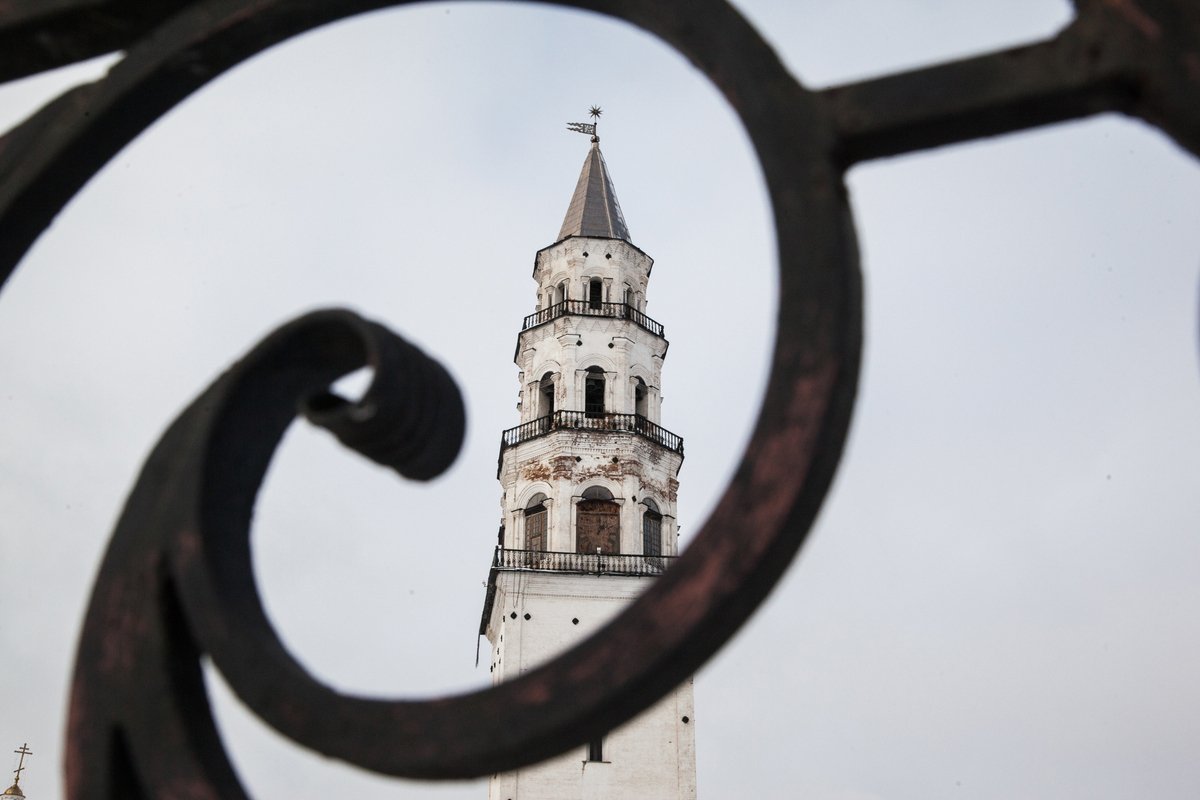
The Nevyansk tower, Photo: Alexey Piskunov, exclusively for Novaya Gazeta Europe
Ivan retells me a conspiracy theory about the war, allegedly, beginning “due to underground resources discovered in Ukraine some time ago”. He is certain that Russia’s actions in the neighbouring country are unacceptable.
“I have friends in Ukraine, I worry about them,” he says. “I keep remembering the [2018] World Cup, us sitting in front of a TV and cheering for Ukraine’s team together. I see too much Russophobia from Ukrainians on social media, but I think one can’t paint us all with the same brush.”
His friend went to war when female nurses started getting drafted under the “partial mobilisation”.
“He couldn’t just stand idly by: ‘I’m a man and I will sit at home while girls are being taken to the front?’” Ivan recalls. “He went to Ukraine as a volunteer doctor. I understand that my friend could come back in a coffin, seeing as today there’s no such thing as a bayonet charge. One can die without ever seeing their enemy in the flesh. On the one hand, it’s important to be a man. But clearly, you can become a dead man very quickly over there.”
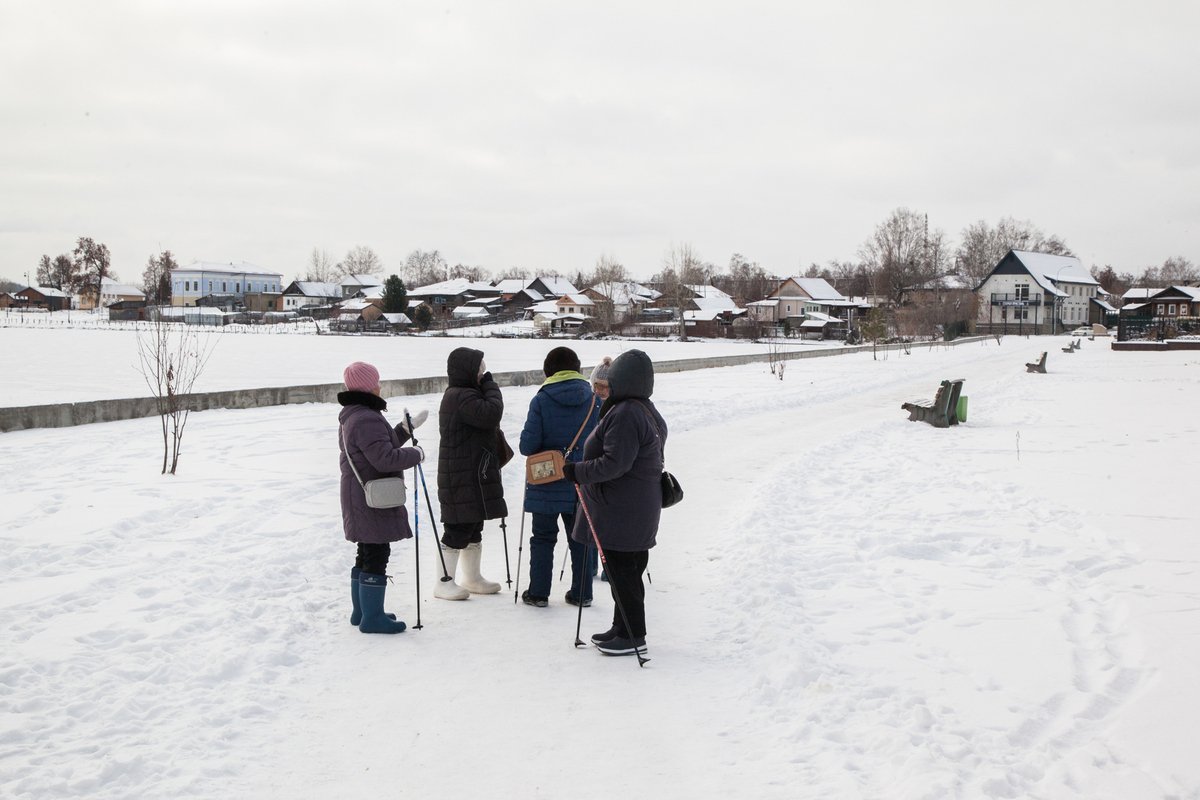
Nevyansk. Photo: Alexey Piskunov, exclusively for Novaya Gazeta Europe
Ivan is also interested in the money side of things.
“Okay, so 195,000 rubles (€3,100) is the pay-out to the mobilised. Although I think that’s a ridiculous number: at least round it up to 200,000, the logic behind how this sum was formed is unclear anyway,” he reflects. “Why not pay people good wages, if there’s actually [this amount of] money in the budget? Actually, the whole thing is shady with these pay-outs. A friend of mine returned from Ukraine and still hasn’t received any money.”
Despite all his doubts, Ivan is certain: if the government imposes martial law and general mobilisation, people will go to draft offices voluntarily.
An ‘audit’ of sentiments
“The only thing I was feeling were cold shivers,” Yevgeny Konovalov, editor-in-chief of the local media outlet Mestnye Vedomosti [Local News], says, recalling 24 February. “But there were a lot of thoughts going through my head: outrage, not wanting to believe what was happening, and deep shame.”
“And I wasn’t ashamed of other people, I was ashamed of myself. For not having written, during my 20-some odd years [as a journalist], a story that would make people not want a war at all. I still don’t understand how this is possible. So many people have relatives [in Ukraine], close kin. I know that I too have distant relatives in Ukraine that I have lost touch with over 20 years ago, after my grandmother’s death. I do have them; I remember them coming to visit us.”
In April, the police drew up three administrative reports on Konovalov for “public actions aimed at discrediting the Russian army” over two articles posted on social media. The first protocol was for an article titled I don’t want our children to be cannon fodder — posted back in February. Konovalov quoted a relative of one of the soldiers deployed to Ukraine in the title. The other two protocols were drawn up for a March article written about the official statement made by Russia’s Defence Ministry about a biological weapon in the form of wild birds.
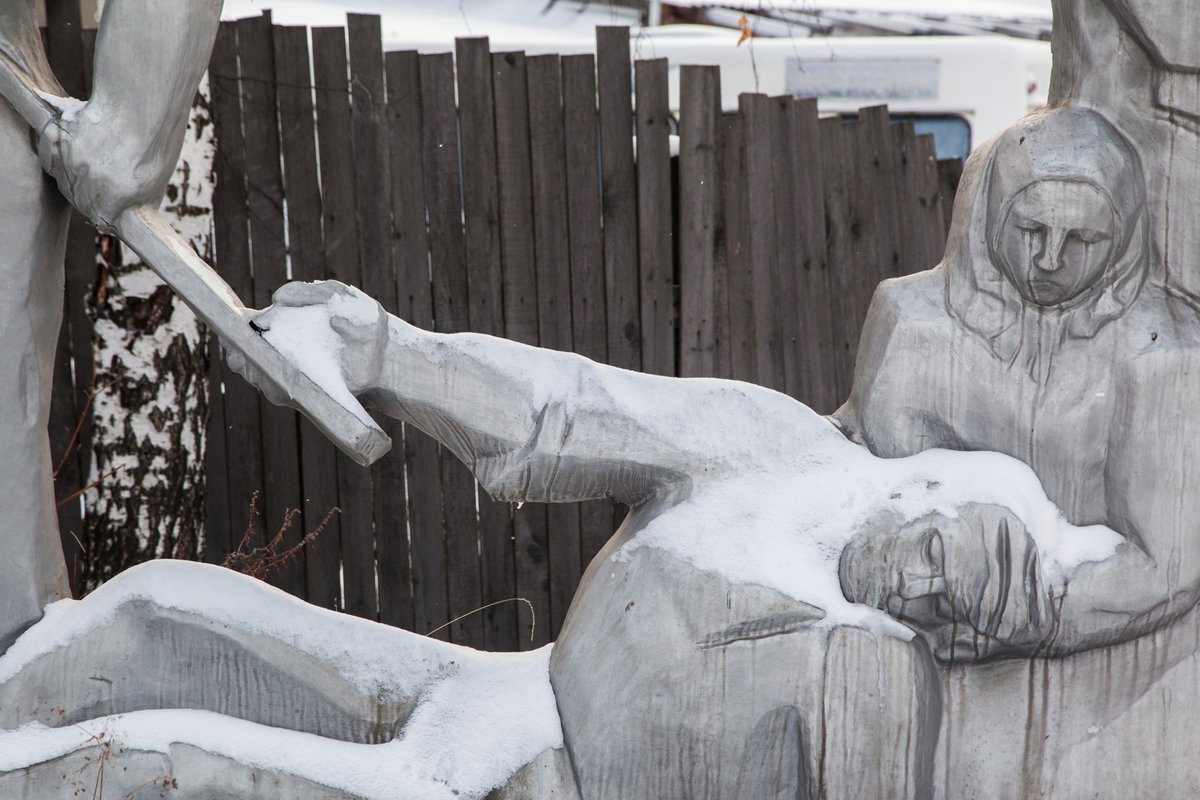
A monument in Nevyansk. Photo: Alexey Piskunov, exclusively for Novaya Gazeta Europe
Konovalov says that both city judges who tried his cases “follow the current news, are not against debate, and are even ready to empathise”. That did not stop the judges from declining his petition about an independent examination being carried out. Konovalov was fined 30,000 rubles (€480) under each protocol. Currently, he is trying to appeal these decisions in the district court.
According to Konovalov, there were no protests in the town after 24 February, no other public expressions of opposing [the war], except for some social media posts, took place either.
“At first, I thought it was very important to conduct an ‘audit’ of sentiments in my inner circle, to make sure that everyone you are counting on in life is also against this insanity,” Konovalov continues. “Unfortunately, it wasn’t so. I was ‘surprised’ by some of my friends that started repeating propaganda slogans. Many were shocked but they expected the government to justify its actions: something like, we’re probably not being told everything, there has to be an actual reason [for the war].
“Running ahead, I will say that some of those people are still expecting to hear from the government, as in during the last nine months, they still haven’t heard something that’d convince them… But the majority of my loved ones, including the people most dear to me, people of all ages, have been against the war since it first started,” he says.
During the first days of the war, a pro-“special military operation” rally was held in Nevyansk. The main participant was a president of the local children’s sports club.
“It turned out that his hatred, referred to as holy, rests on two pillars: memories of army service and the fact that the soldiers serving on the front line today are his students, doing contract service,” Yevgeny says of his conversation with the president. “Later, other participants of the rally confessed that they do not support the operation specifically but the boys who are involved in it. Since then, nothing like that has happened [in the town], if you don’t count collecting humanitarian aid for the draftees, which once again, is only happening to support the guys so that they’re more likely to come back home alive.”
According to Yevgeny, the mood in the town has changed since February. Even before the “partial mobilisation” announcement, the number of stickers in support of the “special operation” on cars has lessened significantly. He gives the example of his neighbour — at the end of February, he “covered his entire car” [in “special operation” memorabilia] and recorded several videos in support of the “special operation”. By the end of September, he had taken all the stickers off of his car and even deleted the videos from his YouTube channel.
“What changed at the scale of the entire town?” Yevgeny reflects. “From my conversations with local officials, I know that all big projects that were started before 24 February — for example, renovation of the embankment or reconstruction of the pool — are still going to be finished, but their completion now costs significantly more, especially since the spring. The price increase has led to additional financing, from the district budget too. I see our leaders happy about the fact that they managed to buy quality European equipment in time, as part of completing these projects… I wrote more than once about factory directors having to find ways through [the complications] because the factories are fitted with imported machines or their products are made with foreign markets in mind.”
The Mestnye Vedomosti newspaper, which Konovalov heads, survives solely based on its own proceeds and regularly participates in municipal auctions on posting information. According to Konovalov, “the editorial office does not say no to writing different articles, including problematic ones, while retaining the most objective approach.” The newspaper also reports on the killed in Ukraine, while choosing its words carefully.

The Nevyansk pond embankment. Photo: Alexey Piskunov, exclusively for Novaya Gazeta Europe
Town losses
There is no public information on the number of draftees from the Nevyansk district. Yevgeny says that on 29 September, the day of the largest deployment from Nevyansk, five buses with mobilised men left the town, four of which had a big number of seats. But the buses were filled not only with town locals but also residents of two nearby districts.
About a third of this number of draftees went to war at the end of October, during the next stage of mobilisation, although there were expectations to deploy many more men: after the first wave and the first funerals, people drew their own conclusions…
We can paint a portrait of an average draftee — who they were, what their lives were like — based on the info available about the first killed mobilised soldiers. Their names are heard around the town a lot. Usually, it is a middle-aged man, nearly forty or over forty, who is survived by his family and several children, who was respected at his place of employment.
“Now, when you talk to their relatives, you realise: not many of them thought that the end would be this tragic, that they would end up on the front lines just a few (!!!) days after leaving home,” Yevgeny continues. “The wives say that their husbands went to ‘do their duty far away from the front line’”.
Even fathers of multiple children (who are supposed to be exempt from mobilisation — translator’s note) were drafted in the Nevyansk urban district. A resident of the village Tsementny, Olga Utemova, is currently fighting an uphill battle with the local officials to make her husband, 39-year-old Vasily Utemov, come back home. The spouses have four children, aged 18, 17, 15, and 9.
“This is a very weird situation, because according to law, we’re a family with multiple children as long as we have three children under 18,” Olga explains. “But I was told in the prosecutor’s office that, under mobilisation, a family is no longer considered to have multiple children as soon as the oldest of the three youngest children turns 16.”
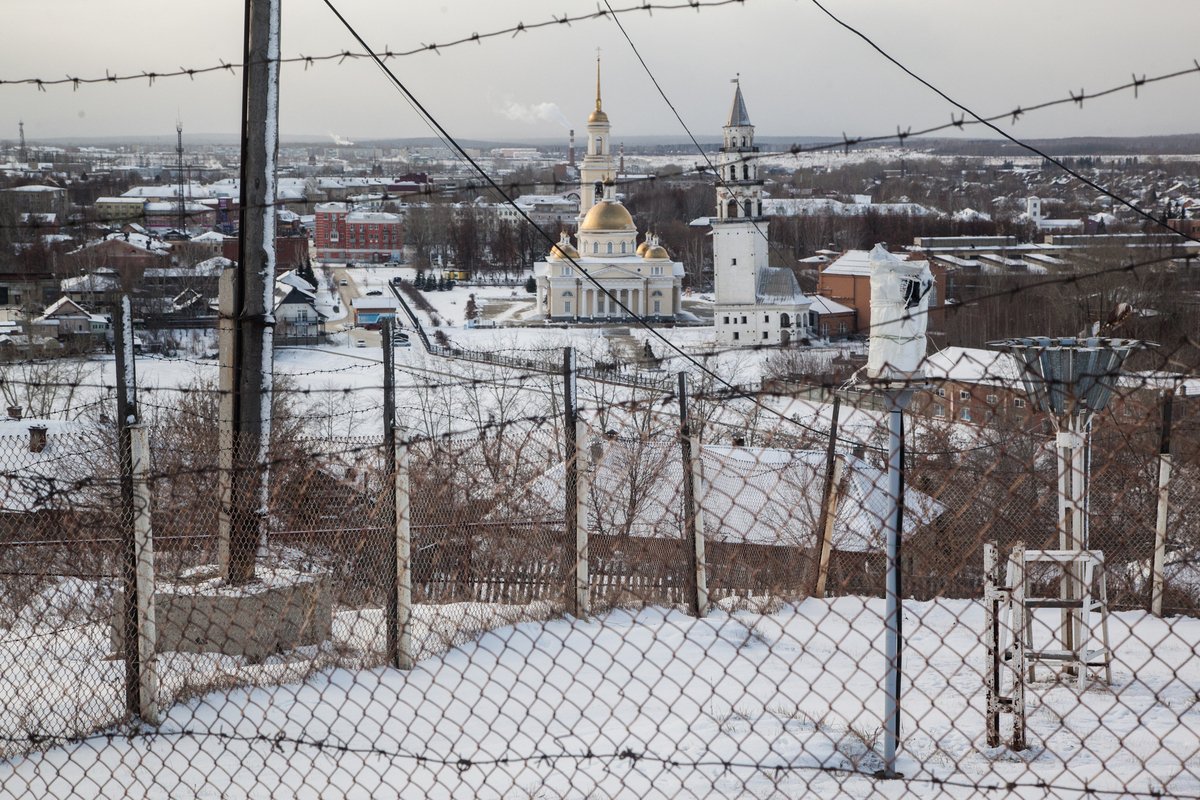
The view of Nevyansk. Photo: Alexey Piskunov, exclusively for Novaya Gazeta Europe
According to Olga, Vasily was mobilised on 29 September; he decided not to evade the draft, because he is an “honest man” and was certain that he would be deployed to “protect the army’s rear or help around”.
Less than two weeks later, on 10 October, he was in Ukraine. But the official documents state that her husband arrived in the fighting unit on 14 October. Furthermore, he has never served in the army and did not graduate from a military department [of a university], but he is listed as a platoon deputy commander and a sergeant, even though he was mobilised as a driver.
“The first pay check of my husband’s came in recently, more than 200,000 rubles (€3,200),” Olga says. “But I still continue writing complaints and asking that Vasily be returned home, as a father of multiple children. I can’t work myself due to health issues, and I have a difficult time on my own with the kids. Why do we need this ‘military’ money when my husband makes good money here too, without risking his life?”
Olga prefers not to say what she thinks about the “special military operation”, as do many female relatives of the draftees.
“Our first contract soldier was killed in the first days of [the ‘special military operation’],” Yevgeny Konovalov says. “Then in late August, two Nevyansk guys were killed, one after another. One of them served in Sakhalin, the other — in the nearby Novouralsk. It became a real tragedy for the town — two soldiers killed at once, no one could’ve guessed what we’d be seeing one and a half months later. Out of volunteer fighters, one of them was killed — a young guy from the village. It’s difficult to say how many of them are fighting. Sometimes, you’re talking to an acquaintance, recalling someone you know, mention that you haven’t seen this person in a while, and you hear: he’s been in Ukraine for a couple of months already.”
Twenty more people are missing. Mothers and wives of the draftees have created a group on social media to support each other. They share information when one of the men is able to call. If there is an opportunity, they interrogate those still fighting, have long conversations with the injured. Everyone hoped that the missing soldiers would be found following the withdrawal from the west bank of the Dnipro River and Kherson. However, after the troops were regrouped, only a few of the missing soldiers had been located.
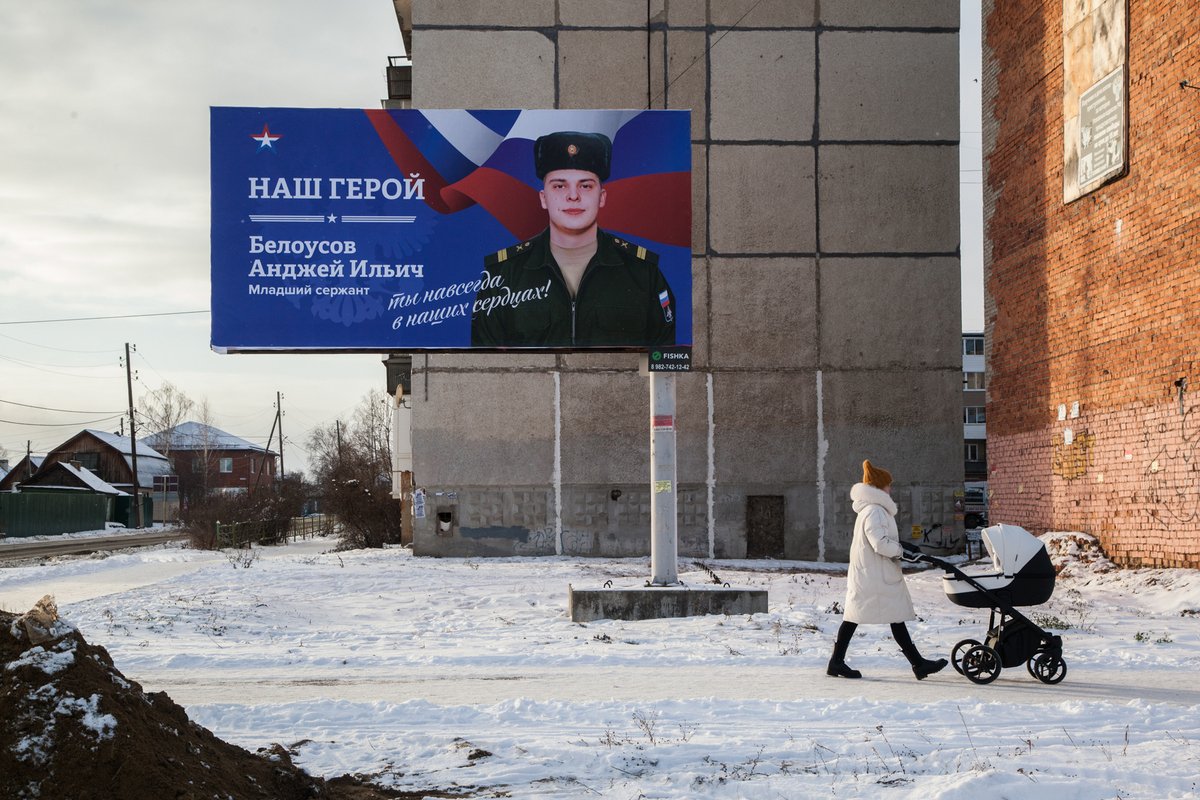
Lenin Street. The billboard reads: ‘Our hero, forever in our hearts!’ Photo: Alexey Piskunov, exclusively for Novaya Gazeta Europe
According to Yevgeny, very few of the locals believe in the “holiness” of this “operation”. He has not heard any mentions of “Nazis” from relatives of the draftees.
“I have seen only one example of an angry outburst towards Ukrainians in recent times,” Yevgeny confesses. “There was a waste paper collection event in the town, and the organisers planned to spend some of the proceeds on helping the draftees. A relative of one of the killed mobilised soldiers — an elderly man — handed over a couple hundred kilos of waste paper, asking: ‘Buy a shell and write ‘For my nephew’ on it!’”
The Nevyansk district has buried ten soldiers — if one counts by the graves in the cemetery. The sites for next funerals to be held are prepared. There are several dozens of injured soldiers in the district. Konovalov says that some of them were told: “Get better, don’t get too comfortable, you’ll have to go back soon.”
Join us in rebuilding Novaya Gazeta Europe
The Russian government has banned independent media. We were forced to leave our country in order to keep doing our job, telling our readers about what is going on Russia, Ukraine and Europe.
We will continue fighting against warfare and dictatorship. We believe that freedom of speech is the most efficient antidote against tyranny. Support us financially to help us fight for peace and freedom.
By clicking the Support button, you agree to the processing of your personal data.
To cancel a regular donation, please write to [email protected]
